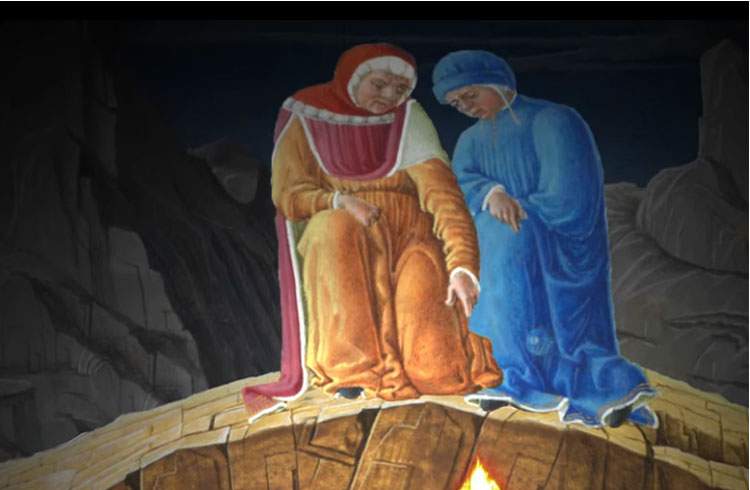A short film presents Ulysses in the Divine Comedy, with the voice of Vittorio Gassman
On the occasion of Dantedì, the major exhibition Ulysses. Art and Myth set up at the San Domenico Museums in Forli features a short film dedicated to the depiction of Ulysses in the Divine Comedy. Starting with some of the famous miniatures that are part of the exhibition itinerary, the exhibition’s artistic direction, chaired by Antonio Paolucci and coordinated by Gianfranco Brunelli, oversaw the direction of a video that combines tradition and innovation, using augmented reality techniques and the extraordinary voice of Vittorio Gassman.
“We immediately took up the solicitation put forward by the Dantedì Promoting Committee, also endorsed by the MiBACT, which for the day of Wednesday, March 25, therefore invites everyone to read Dante’s verses,” said Brunelli, adding, "Rai will also actively participate in Dantedì, selecting from its thecae the lecturae Dantis interpreted by the greatest artists of our time, programmed in short pills on Rai’s three generalist networks and on Rai Play. And it is in this context that the programming of the short film made as part of the major Forlì exhibition " Ulysses. Art and Myth."
A similar initiative will also be proposed on the MiBACT YouTube channel and on the Corriere della sera website. The Forlì short film will remain visible, even in the following days, on the Forlì Foundation’s YouTube channel.
Below the exhibition offers the introductory text to the exhibition section dedicated to Dante.
"For the High Open Sea. Dante and the overcoming of the ancient world
Dante, writing two thousand years after the so-called Homer, does not directly use the Greek tradition, but the Latin tradition (Cicero, Statius, Virgil, Horace, Ovid), which unlike the post-Homerics revalued the human qualities of Ulysses. In Canto XXVI of the Inferno, Dante can give Ulysses a new and different centrality for this.
To the point of superimposing his Ulysses on Homer’s. His Ulysses no longer belongs to the cycle of nostoi, of returns from Troy. He is, if anything, a figure open to the new world. His protagonist is not driven by the nostalgia of return, nor, like the Virgilian Aeneas, by a mission; he is a wayfarer, driven by ardor “to become of the world expert / and of human vices and valor,” and he launches himself “by other open sea,” toward the “mad flight.”
A powerful and controversial story, Dante’s version of Ulysses, in which the two destinies (Dante and Ulysses) meet and overlap, as the Comedy is also a journey - involving the Christian vision of man’s destiny precisely in its confrontation with ancient ethics.
In the Dante narrative, placed in the 8th bolgia, that of the fraudulent, Odysseus shows up with Diomedes along with whom he stole the palladium from Troy and is remembered as the architect of the horse’s deception. But Dante’s narrative goes further. It is of the end of Odysseus that Dante wants to speak. Of that end of his existence of which the poets (Virgil, Cicero and Horace) have not told. Ulysses’ tale is not about his sin as a deceiver, for which he is condemned. His tale opens to the recognition of reason, of the mind: the highest faculty of man, which in the Convivio is called “deitade” by Dante. Here Ulysses’ journey is inscribed in the relationship between Grace and Nature, and pertains to the recognition of the natural limit.
Dante constructs the episode as a grand fresco on the virtues and limits of the ancient world. Horace’s words “quid virtus et quid sapientia possit, utile proposuit nobis exemplar Ulixen...” resonate here to remind us of his human vicissitude, the adventure of his human mind, bent on the primacy of knowledge (“Consider your seed: / made not to live like brutes, / but to follow virtue and knowledge”). And the problem is the dialectic between virtue and knowledge, the measure of the limit. This fascinates Dante. And this is the problem that, coming out of the Middle Ages, Dante delivers to Renaissance humanism.
The influence of Dante and his Ulysses on art is closely linked to the creation of the illustrated cycles (between manuscripts and early printed editions) of the Commedia. It is initially a textual interest, linked to the illustrative set, but with the passage of time it becomes interpretive. The illustrative masterpieces of Mariotto di Nardo and Guglielmo Giraldi in the Biblioteca Apostolica Vaticana, or the Miniatore of the Marciana, up to the Dante istoriato e illustrato of Botticelli and then Zuccari, mark an influence that independently painting will take charge of first to accompany and later, especially in the nineteenth century (Dante’s true century in art), to develop autonomously, making the individual characters live out their own history, in a story almost detached from Dante’s poem. But if there is one interpretive passage that will influence later iconography this is perhaps the Landinian commentary on the Comedy. Landino presupposes in Dante the same purpose that Homer and Virgil had set for themselves, to demonstrate “the one by Ulixe, the other by Aeneas [...] in what way coming into the cognitione de’ vitii et conosciutogli, purgandosi da quegli, s’arriva finalmente alla contemplazione delle chose divine.” An almost complete legitimization of the ancient in Christian humanism.
At this link you can see the short film
 |
| A short film presents Ulysses in the Divine Comedy, with the voice of Vittorio Gassman |
Warning: the translation into English of the original Italian article was created using automatic tools. We undertake to review all articles, but we do not guarantee the total absence of inaccuracies in the translation due to the program. You can find the original by clicking on the ITA button. If you find any mistake,please contact us.





























